University–Industry Technology Transfer: Empirical Findings from Chinese Industrial Firms
Abstract
1. Introduction
2. Literature Review and Theoretical Background
2.1. Background of Chinese University–Industry Technology Transfer
2.2. Recent Studies about SNA on Technology Transfer
3. Materials and Methods
3.1. Schematic of Research Procedure
3.2. License Transfer Data Collection
3.3. Data Collection from Firms
3.4. Unipartite and Bipartite Networks
3.5. Centrality Indices in Bipartite Social Network
3.6. Empirical Analysis Method
4. Results
4.1. Overview of Full Network Representing Chinese University-Firm Knowledge Transfer
4.2. Visualization of Dynamics of Chinese University–Firm Knowledge Transfer Network
4.3. Visualization of Geographically Mapped Centrality Scores
4.4. Visualization and Summarization of Centrality Score
4.5. Results of Empirical Analysis
4.5.1. Correlation Test
4.5.2. Empirical Analysis Results for BGRM and BiRank Models
5. Discussion
6. Conclusions
- When analyzing a bipartite network, a common analysis method involves changing the bipartite network into a unipartite network, which can then be analyzed with standard techniques. However, unipartite projections often destroy important structural information. Our research serves to close this gap by giving each node in a bipartite network a centrality estimate, while still considering the edge weight, e.g., the number of license contracts between paired universities and firms.
- Previously, few studies have captured how knowledge transfer networks evolve over time or combined the time series with geographical features, e.g., visualized knowledge transfer network dynamics on a map. We created visualizations of the university knowledge transfer network and observed its year-by-year evolution by setting the licensing year as the time truncation using the SNA tool Gephi. We used snapshots representing license transfers in 2009, 2011, and 2013 to visualize and capture the dynamics of Chinese university–firm technology transfer. Our visualization results showed that nearly all universities and firms that have patent license transfer contracts are in China’s southeastern, economically developed areas, with the most license transfers in the Yangtze River economic zone and the Pearl River Delta economic zone. In northern China, most universities and firms are clustered around Beijing and Tianjin. Furthermore, in accord with previous research, we observed that innovation capabilities, R&D resources, and technology transfer performance varied across China, and that patent licensing networks present clear small-world phenomena.
- We highlighted BGRM and BiRank centrality in a bipartite network and investigated the relationship between them. We found that firms having high BGRM centrality most often also have high BiRank centrality, and there is a relatively strong positive correlation between the BGRM centrality and BiRank centrality estimates.
- Our empirical analysis results revealed that firms with high BGRM or BiRank centralities have greater innovative output. Furthermore, firms with a long history and fewer employees also have greater innovative output.
Author Contributions
Funding
Institutional Review Board Statement
Informed Consent Statement
Data Availability Statement
Conflicts of Interest
References
- Leydesdorff, L.; Etzkowitz, H. Emergence of a Triple Helix of university—Industry—Government relations. Sci. Public Policy 1996, 23, 279–286. [Google Scholar] [CrossRef]
- Leydesdorff, L.; Etzkowitz, H. The triple helix as a model for innovation studies. Sci. Public Policy 1998, 25, 195–203. [Google Scholar] [CrossRef]
- Etzkowitz, H.; Leydesdorff, L. The dynamics of innovation: From National Systems and “Mode” to a Triple Helix of university–industry–government relations. Res. Policy 2000, 29, 109–123. [Google Scholar] [CrossRef]
- Mansfield, E. Academic research and industrial innovation. Res. Policy 1991, 20, 1–12. [Google Scholar] [CrossRef]
- Pavitt, K. What makes basic research economically useful? Res. Policy 1991, 20, 109–119. [Google Scholar] [CrossRef]
- Rosenberg, N.; Nelson, R.R. American universities and technical advance in industry. Res. Policy 1994, 23, 323–348. [Google Scholar] [CrossRef]
- Salter, A.J.; Martin, B.R. The economic benefits of publicly funded basic research: A critical review. Res. Policy 2001, 30, 509–532. [Google Scholar] [CrossRef]
- Brennenraedts, R.; Bekkers, R.; Verspagen, B. The Different Channels of University-Industry Knowledge Transfer: Empirical Evidence from Biomedical Engineering; ECIS Working Paper Series; Technische Universiteit Eindhoven: Eindhoven, The Netherlands, 2006; Volume 200604, Available online: https://research.tue.nl/en/publications/the-different-channels-of-university-industry-knowledge-transfer- (accessed on 2 August 2022).
- Faulkner, W.; Senker, J. Making sense of diversity: Public-private sector research linkage in three technologies. Res. Policy 1994, 23, 673–695. [Google Scholar] [CrossRef]
- Cohen, W.M.; Nelson, R.R.; Walsh, J.P. Links and impacts: The influence of public research on industrial R&D. Manag. Sci. 2002, 48, 1–23. [Google Scholar] [CrossRef]
- D’Este, P.; Patel, P. University–industry linkages in the UK: What are the factors underlying the variety of interactions with industry? Res. Policy 2007, 36, 1295–1313. [Google Scholar] [CrossRef]
- Gao, X.; Chen, Y.; Song, W.; Peng, X.; Song, X. Mapping and evaluating regional university-industry knowledge flow through patent licensing. Open J. Soc. Sci. 2015, 3, 53107. [Google Scholar] [CrossRef][Green Version]
- Bozeman, B. Technology transfer and public policy: A review of research and theory. Res. Policy 2000, 29, 627–655. [Google Scholar] [CrossRef]
- Jiang, J.; Goel, R.K.; Zhang, X. Knowledge flows from business method software patents: Influence of firms’ global social networks. J. Technol. Transf. 2019, 44, 1070–1096. [Google Scholar] [CrossRef]
- Cao, X.; Li, C. Evolutionary game simulation of knowledge transfer in industry-university-research cooperative innovation network under different network scales. Sci. Rep. 2020, 10, 4027. [Google Scholar] [CrossRef]
- Ye, Y.; De Moortel, K.; Crispeels, T. Network dynamics of Chinese university knowledge transfer. J. Technol. Transf. 2020, 45, 1228–1254. [Google Scholar] [CrossRef]
- Zaheer, A.; Bell, G.G. Benefiting from network score: Firm capabilities, structural holes, and performance. Strateg. Manag. J. 2005, 26, 809–825. [Google Scholar] [CrossRef]
- Kleinberg, J.M. Authoritative sources in a hyperlinked environment. J. ACM 1999, 46, 604–632. [Google Scholar] [CrossRef]
- Borgatti, S.P.; Everett, M.G. Network analysis of 2-mode data. Soc. Netw. 1997, 19, 243–269. [Google Scholar] [CrossRef]
- Hanneman, R.A.; Riddle, M. Introduction to Social Network Methods: Table of Contents; University of California: Riverside, CA, USA, 2005; Volume 13, Available online: http://faculty.ucr.edu/~hanneman/ (accessed on 2 August 2022).
- Yang, W.; Yu, X.; Wang, D.; Yang, J.; Zhang, B. Spatio-temporal evolution of technology flows in China: Patent licensing networks 2000–2017. J. Technol. Transf. 2019, 46, 1674–1703. [Google Scholar] [CrossRef]
- Zhao, J.; Wu, G. Evolution of the Chinese Industry-University-Research Collaborative Innovation System. Complexity 2017, 2017, 4215805. [Google Scholar] [CrossRef]
- Hong, W. Decline of the center: The decentralizing process of knowledge transfer of Chinese universities from 1985 to 2004. Res. Policy 2008, 37, 580–595. [Google Scholar] [CrossRef]
- De Moortel, K.; Crispeels, T. International university-university technology transfer: Strategic management framework. Technol. Forecast. Soc. Chang. 2018, 135, 145–155. [Google Scholar] [CrossRef]
- Gao, X.; Guan, J.; Rousseau, R. Mapping collaborative knowledge production in China using patent co-inventorships. Scientometrics 2011, 88, 343–362. [Google Scholar] [CrossRef]
- Chen, A.; Patton, D.; Kenney, M. University technology transfer in China: A literature review and taxonomy. J. Technol. Transf. 2016, 41, 891–929. [Google Scholar] [CrossRef]
- Clarkson, G. Patent Informatics for Patent Thicket Detection: A Network Analytic Approach for Measuring the Density of Patent Space; University of Michigan: Ann Arbor, MI, USA, 2005. [Google Scholar]
- Leydesdorff, L.; Vaughan, L. Co-occurrence matrices and their applications in information science: Extending ACA to the Web environment. J. Am. Soc. Inf. Sci. Technol. 2006, 57, 1616–1628. [Google Scholar] [CrossRef]
- Sternitzke, C.; Bartkowski, A.; Schramm, R. Visualizing patent statistics by means of social network analysis tools. World Pat. Inf. 2008, 30, 115–131. [Google Scholar] [CrossRef]
- Zhang, G.; Duan, H.; Zhou, J. Investigating determinants of inter-regional technology transfer in China: A network analysis with provincial patent data. Rev. Manag. Sci. 2014, 10, 345–364. [Google Scholar] [CrossRef]
- Lu, L.; Huang, R. Urban hierarchy of innovation capability and inter-city linkages of knowledge in post-reform China. Chin. Geogr. Sci. 2012, 22, 602–616. [Google Scholar] [CrossRef]
- López-Cruz, O.; Obregón, N. A Network Based Methodology to Reveal Patterns in Knowledge Transfer. Int. J. Interact. Multimed. Artif. Intell. 2015, 3, 67–76. [Google Scholar] [CrossRef][Green Version]
- Graf, H.; Kalthaus, M. International research networks: Determinants of country embeddedness. Res. Policy 2018, 47, 1198–1214. [Google Scholar] [CrossRef]
- Fleming, L.; King, C.; Juda, A.I. Small Worlds and Regional Innovation. Organ. Sci. 2007, 18, 938–954. [Google Scholar] [CrossRef]
- Balconi, M.; Breschi, S.; Lissoni, F. Networks of inventors and the role of academia: An exploration of Italian patent data. Res. Policy 2004, 33, 127–145. [Google Scholar] [CrossRef]
- Latapy, M.; Magnien, C.; Vecchio, N.D. Basic notions for the analysis of large two-mode networks. Soc. Netw. 2008, 30, 31–48. [Google Scholar] [CrossRef]
- Jiang, J.; Goel, R.K.; Zhang, X. IPR policies and determinants of membership in Standard Setting Organizations: A social network analysis. NETNOMICS Econ. Res. Electron. Netw. 2020, 21, 129–154. [Google Scholar] [CrossRef]
- Lehmann, S.; Schwartz, M.; Hansen, L.K. Biclique communities. Phys. Rev. E Stat. Nonlin. Soft. Matter. Phys. 2008, 78 Pt 2, 016108. [Google Scholar] [CrossRef] [PubMed]
- Aronson, B.; Yang, K.C.; Odabas, M.; Ahn, Y.Y.; Perry, B.L. Comparing Measures of Centrality in Bipartite Social Networks: A Study of Drug Seeking for Opioid Analgesics. Available online: https://osf.io/preprints/socarxiv/hazvs/ (accessed on 2 August 2022).
- Krasanakis, E.; Schinas, E.; Papadopoulos, S.; Kompatsiaris, Y.; Mitkas, P.A. VenueRank: Identifying Venues that Contribute to Artist Popularity. In Proceedings of the 19th ISMIR Conference, Paris, France, 23–27 September 2018; pp. 702–708. [Google Scholar]
- Liao, H.; Wu, J.; Mao, Y.; Zhou, M.; Vidmer, A.; Lu, K. Addressing time bias in bipartite graph ranking for important node identification. Inf. Sci. 2020, 540, 38–50. [Google Scholar] [CrossRef]
- De Nooy, W.; Mrvar, A.; Batagelj, V. Exploratory Social Network Analysis with Pajek, 2nd ed.; Cambridge University Press: Cambridge, UK; New York, NY, USA, 2011; p. 6. [Google Scholar] [CrossRef]
- Deng, H.; Lyu, M.R.; King, I. A generalized co-hits algorithm and its application to bipartite graphs. In Proceedings of the 15th ACM SIGKDD International Conference on Knowledge Discovery and Data Mining, Paris, France, 28 June–1 July 2009; pp. 239–248. [Google Scholar] [CrossRef]
- Rui, X.; Li, M.; Li, Z.; Ma, W.Y.; Yu, N. Bipartite graph reinforcement model for web image annotation. In Proceedings of the 15th ACM International Conference on Multimedia, Augsburg, Germany, 25–29 September 2007; pp. 585–594. [Google Scholar] [CrossRef]
- He, X.; Gao, M.; Kan, M.Y.; Wang, D. Birank: Towards ranking on bipartite graphs. IEEE Trans. Knowl. Data Eng. 2016, 29, 57–71. [Google Scholar] [CrossRef]
- Yang, K.C.; Aronson, B.; Ahn, Y.Y. BiRank: Fast and Flexible Ranking on Bipartite Networks with R and Python. J. Open Source Softw. 2020, 5, 2315. [Google Scholar] [CrossRef]
- Lanjouw, J.O.; Pakes, A.; Putnam, J. How to count patents and value intellectual property: The uses of patent renewal and application data. J. Ind. Econ. 1998, 46, 405–432. [Google Scholar] [CrossRef]
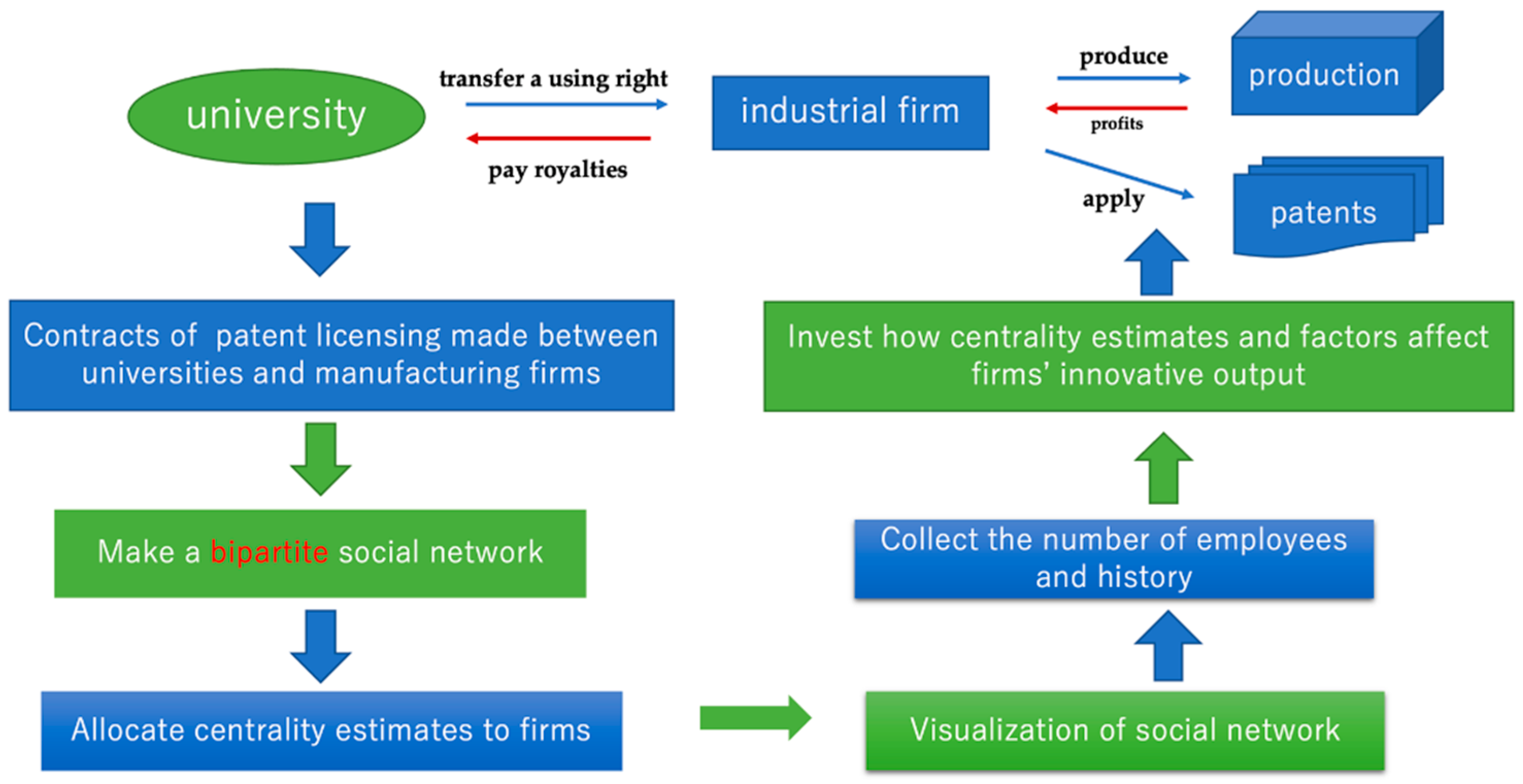
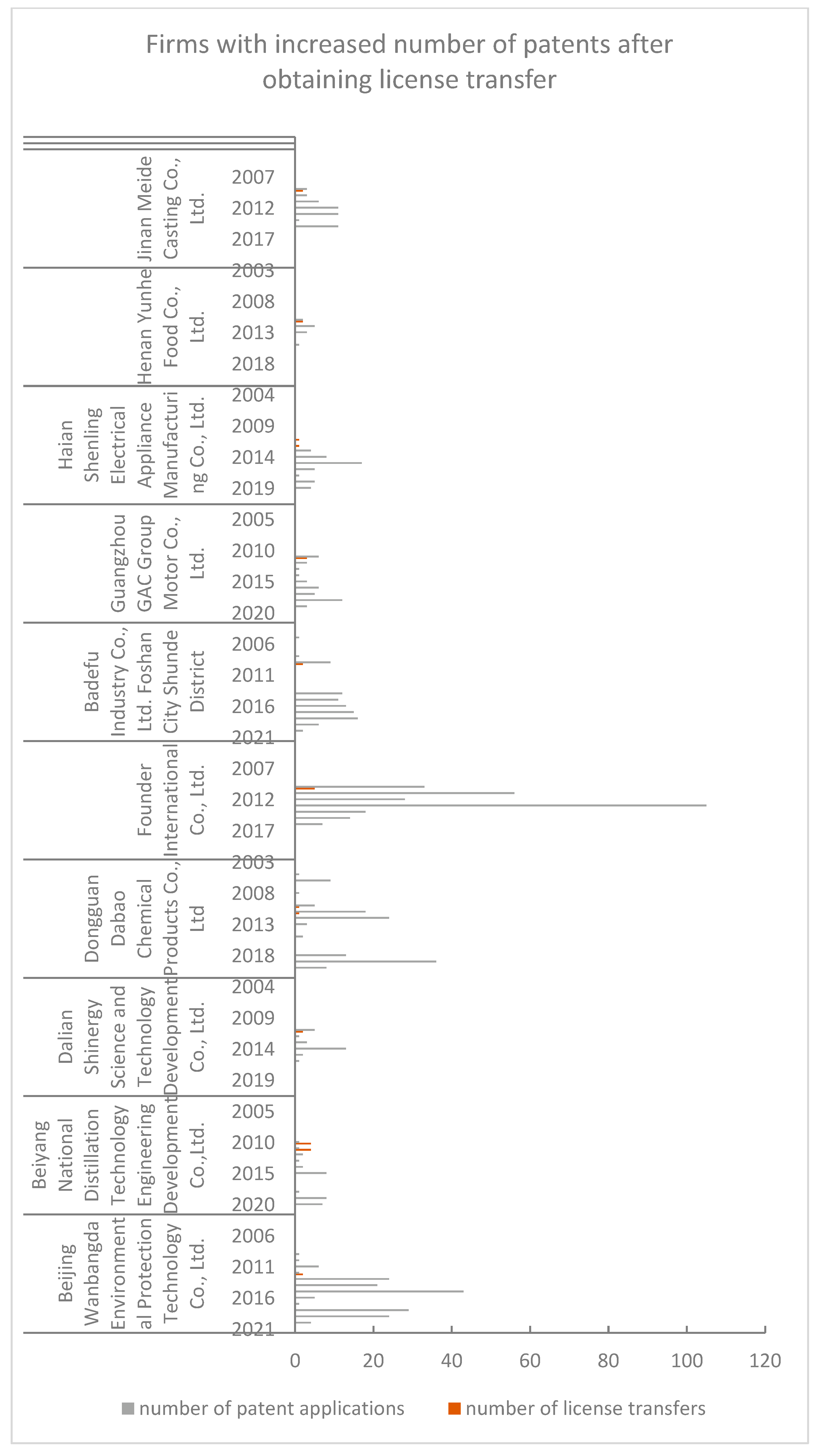
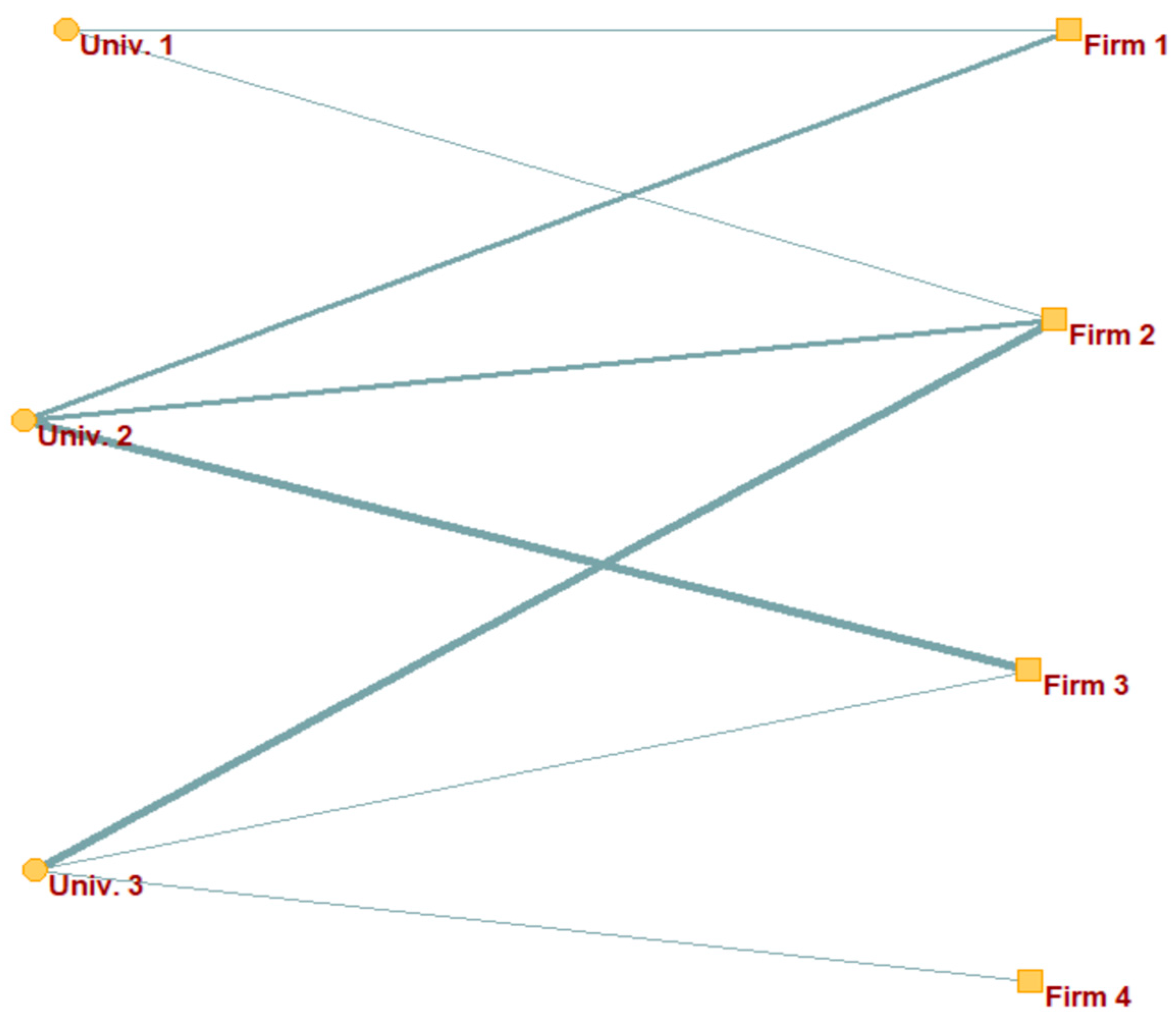
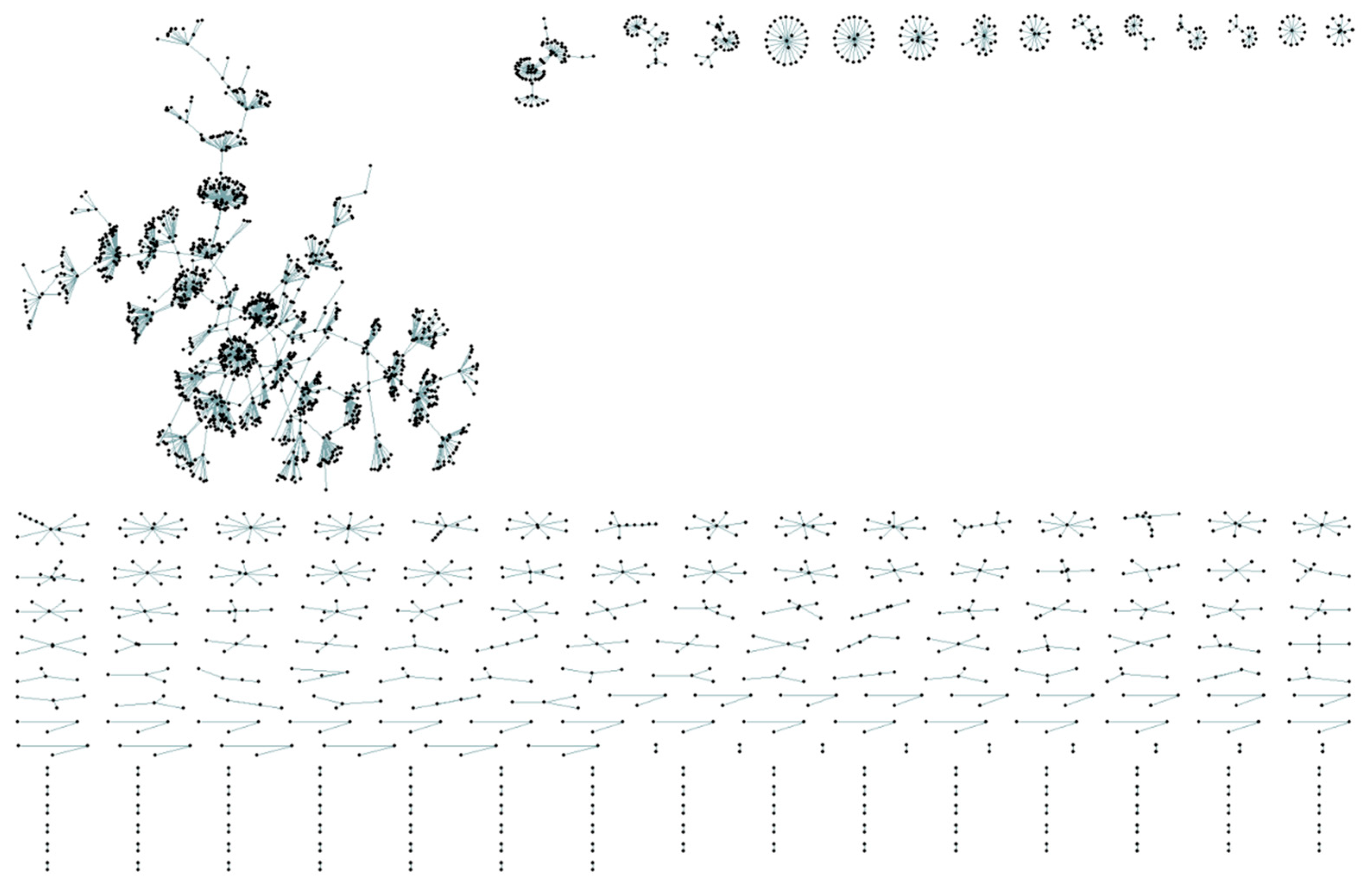
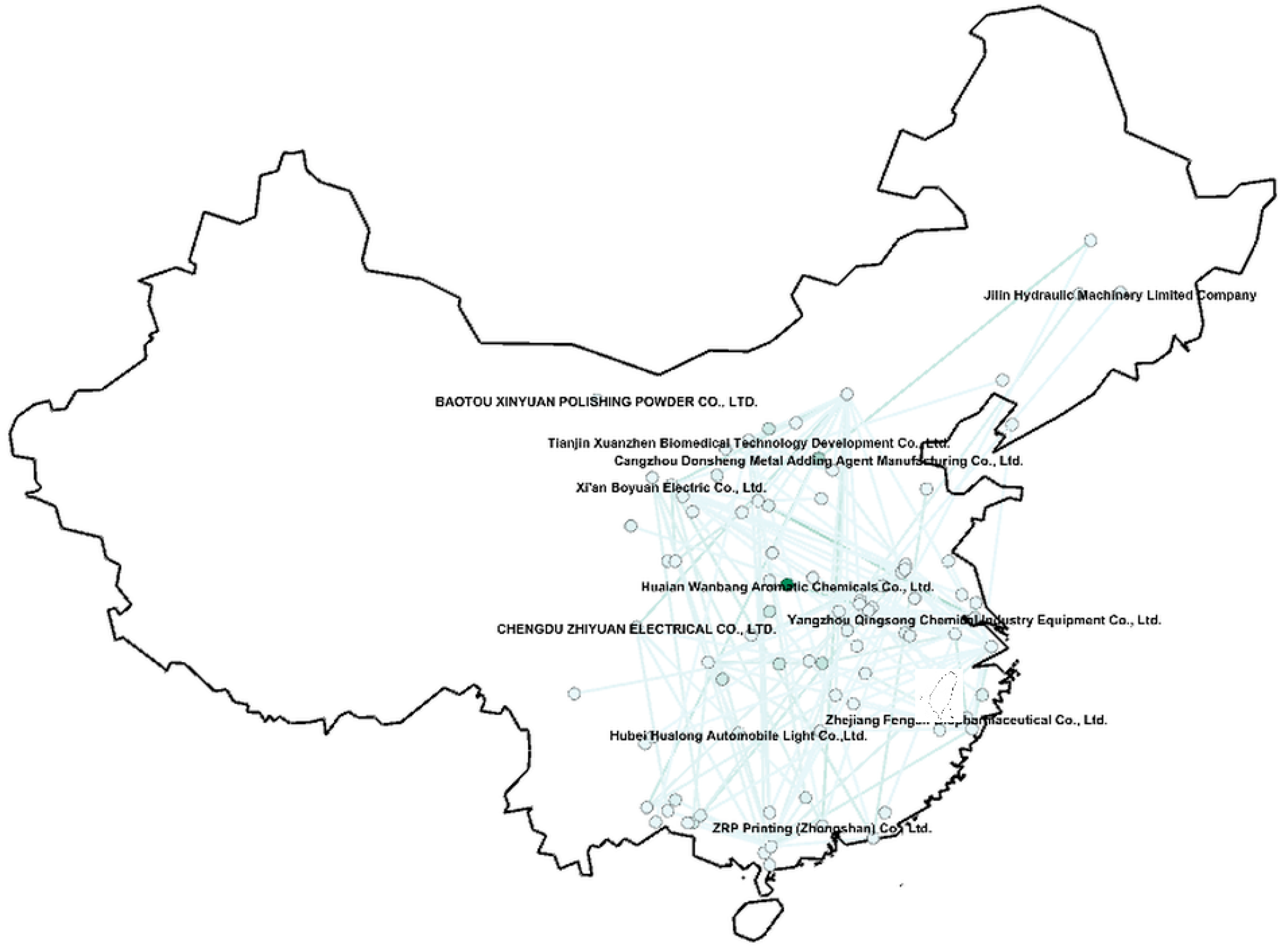
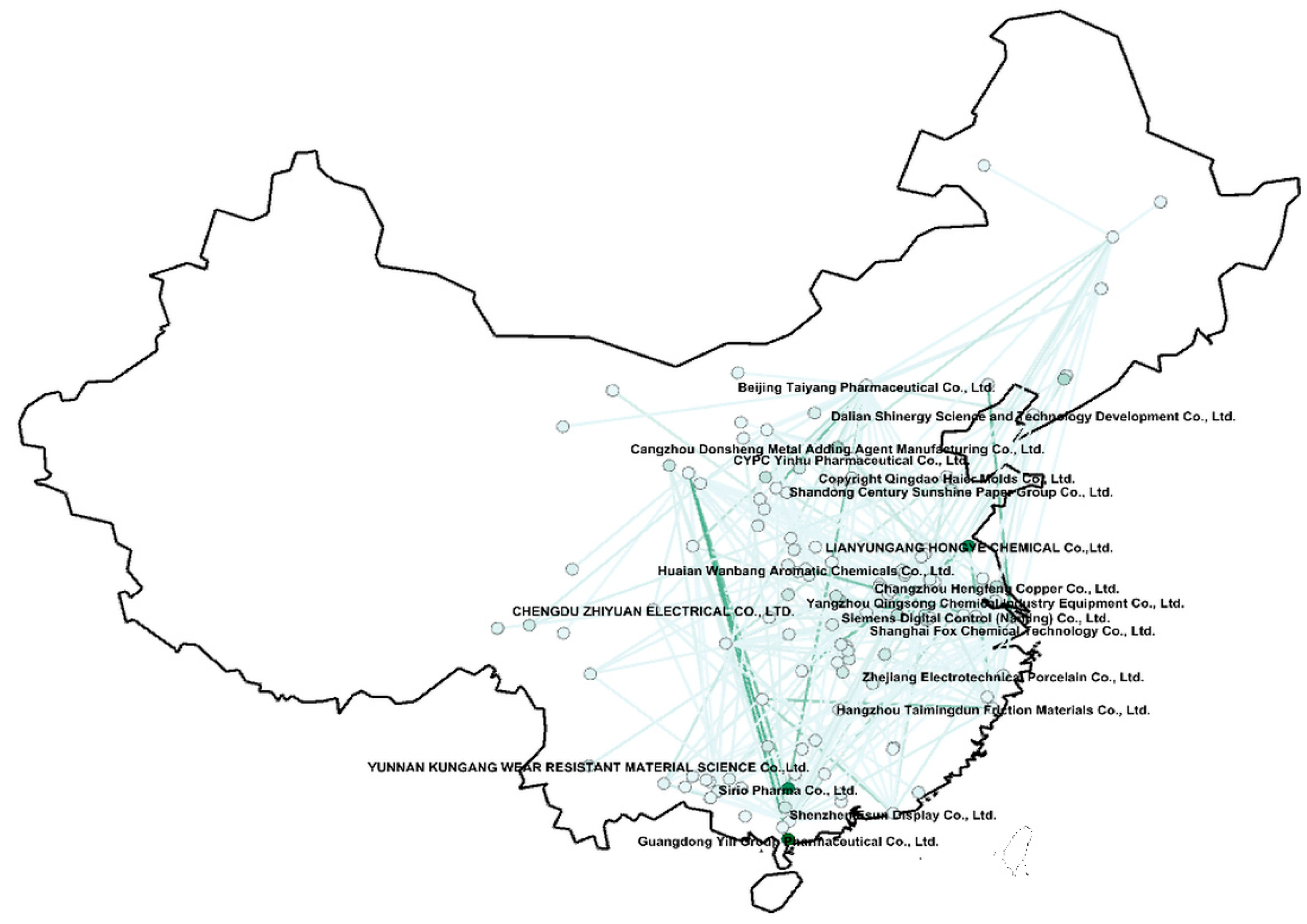
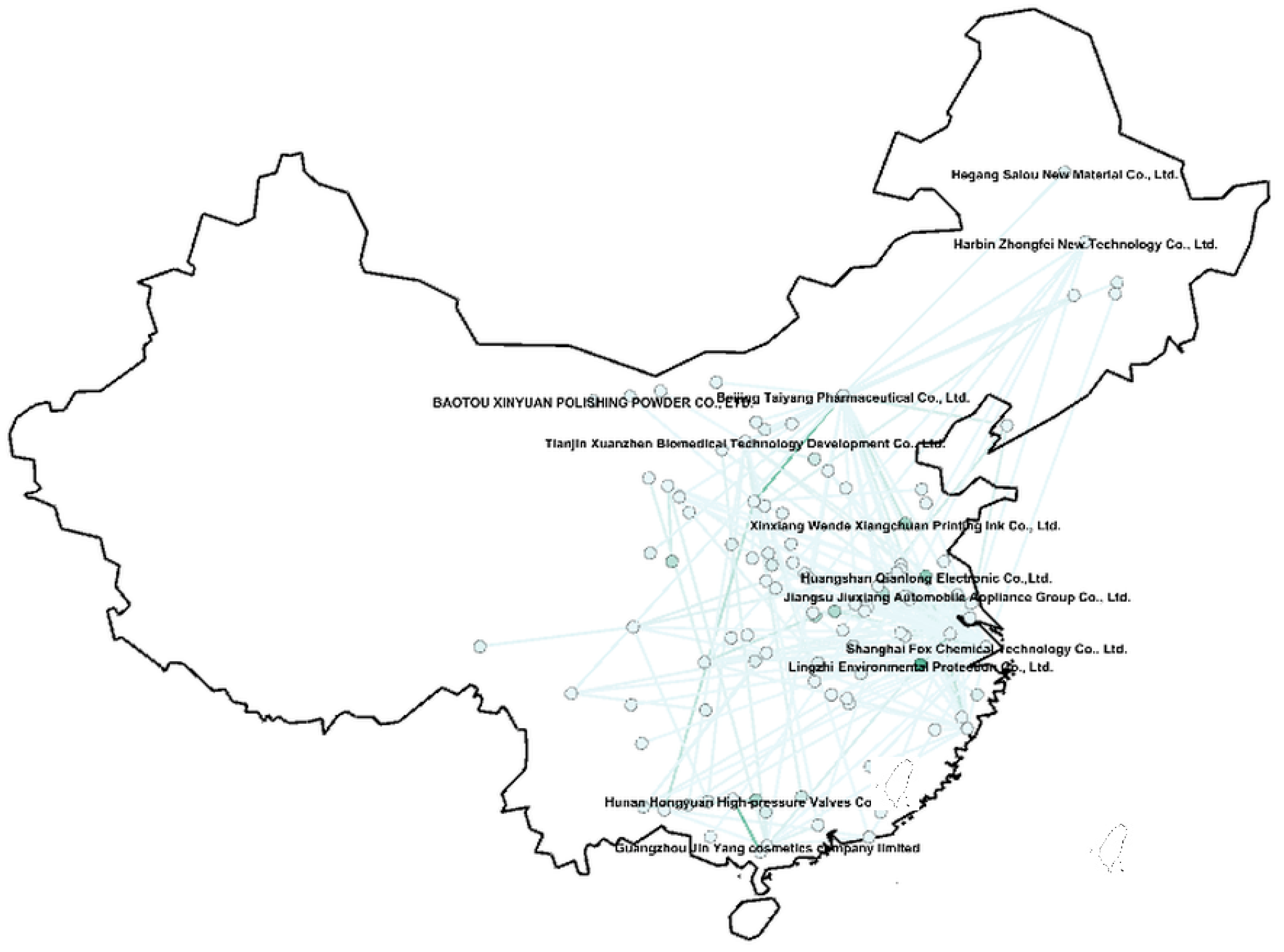
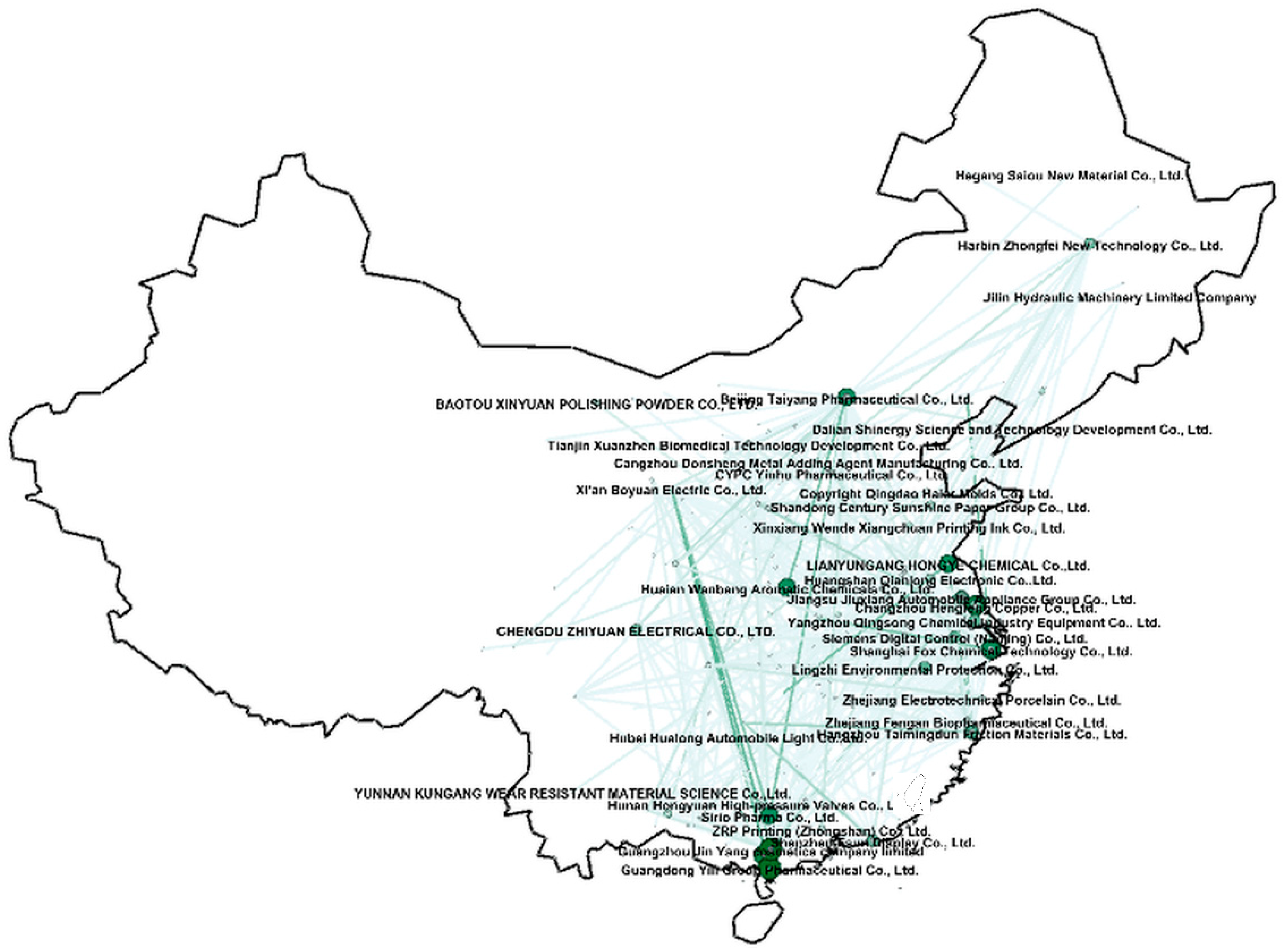
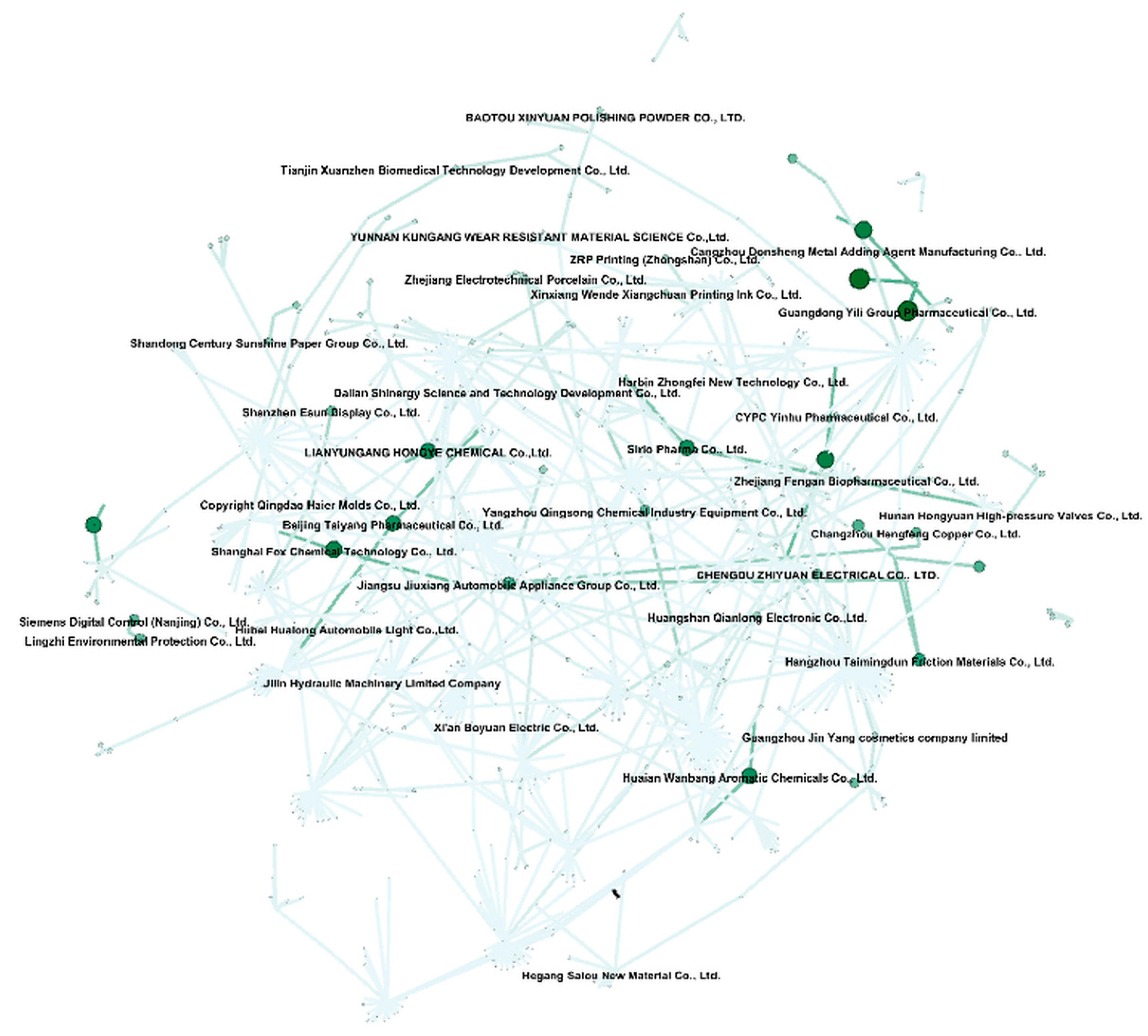
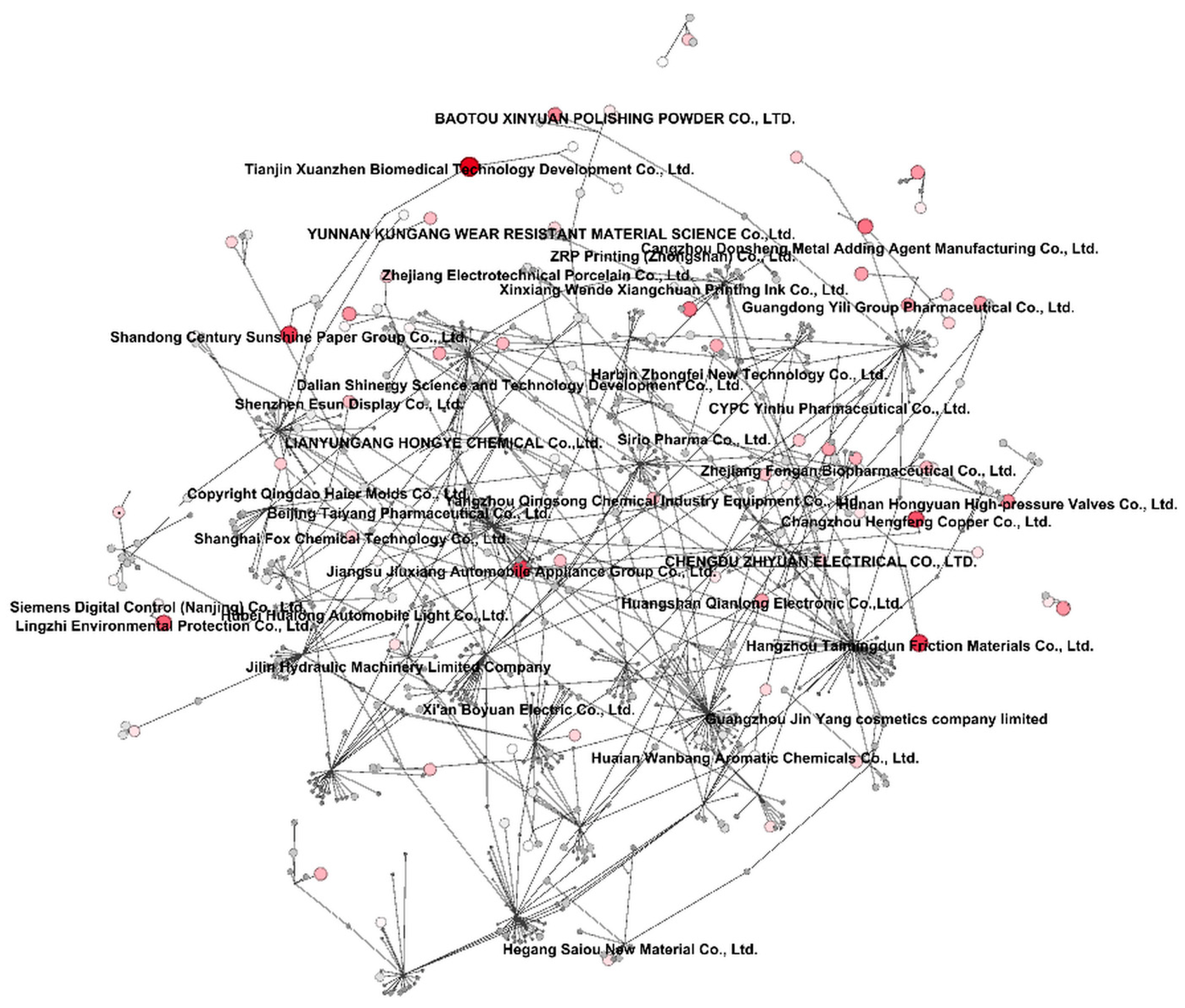

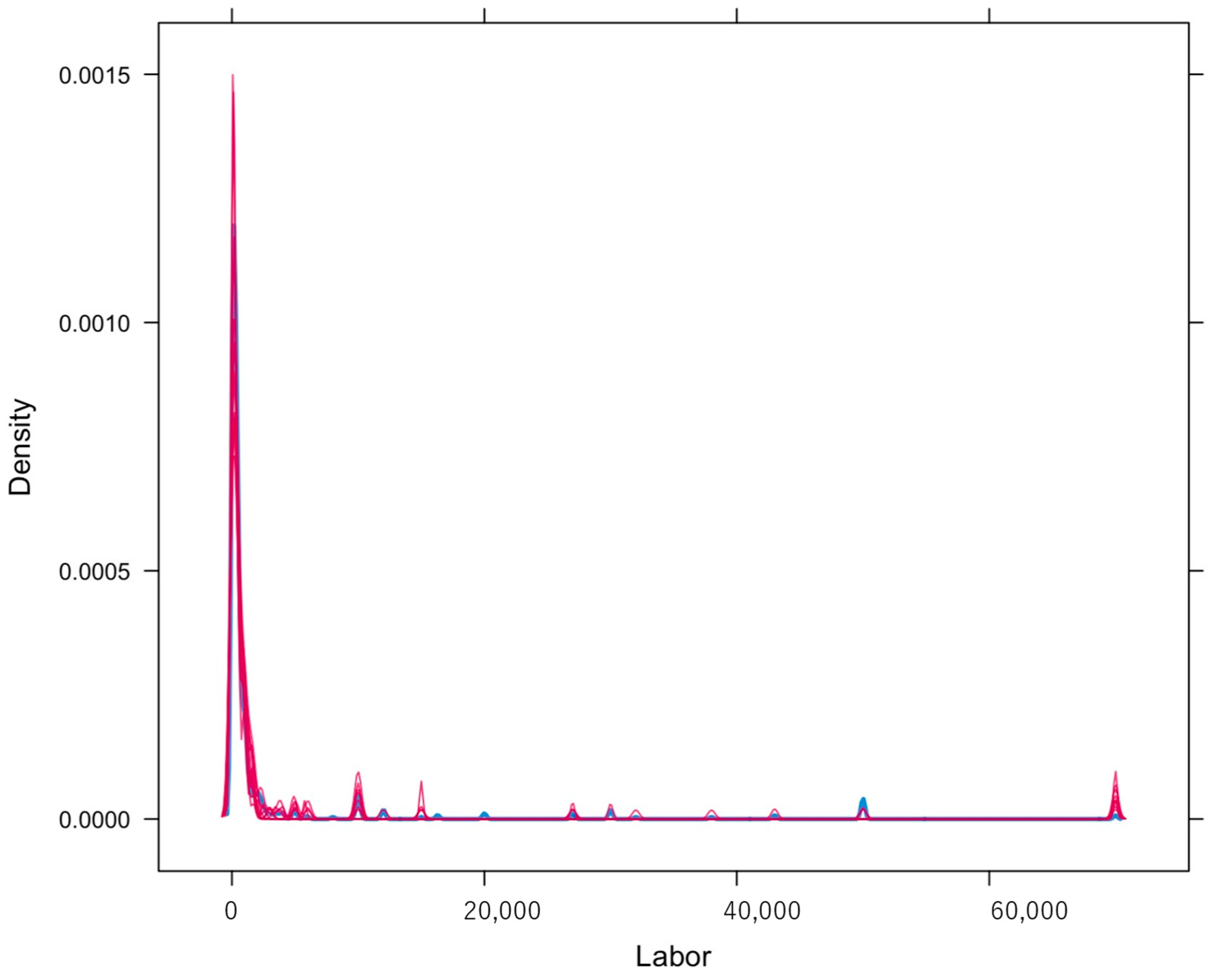
| Name of Firm | BGRM Centrality | BiRank Centrality |
|---|---|---|
| Guangdong Yili Group Pharmaceutical Co., Ltd. | 0.0013824 | 0.004137 |
| Changzhou Fanqun Drying Equipment Co., Ltd. | 0.0012163 | 0.0041057 |
| Shanghai Fox Chemical Technology Co., Ltd. | 0.0011935 | 0.0037608 |
| Shanghai Taiho Paint Products Co., Ltd. | 0.0011187 | 0.0036851 |
| Lianyungang Hongye Chemical Co., Ltd. | 0.0010962 | 0.0032432 |
| Huaian Wanbang Aromatic Chemicals Co., Ltd. | 0.0010925 | 0.0032684 |
| Sirio Pharma Co., Ltd. | 0.0010862 | 0.0030402 |
| Beijing Taiyang Pharmaceutical Co., Ltd. | 0.0010843 | 0.0031152 |
| Hangzhou Taimingdun Friction Materials Co., Ltd. | 0.0009244 | 0.0050411 |
| Jiangsu Jiuxiang Automobile Appliance Group Co., Ltd. | 0.0008878 | 0.0049912 |
| Jiangmen Kingbord Laminates Holdings Ltd. | 0.0008149 | 0.003535 |
| Yangzhou Qingsong Chemical Industry Equipment Co., Ltd. | 0.000785 | 0.0038608 |
| Lingzhi Environmental Protection Co., Ltd. | 0.0007702 | 0.0047376 |
| Siemens Digital Control (Nanjing) Co., Ltd. | 0.0007702 | 0.0034082 |
| Changzhou Hengfeng Copper Co., Ltd. | 0.0007416 | 0.0048171 |
| Shenzhen Esun Display Co., Ltd. | 0.000724 | 0.0038745 |
| Chengdu Zhiyuan Electrical Co., Ltd. | 0.0007233 | 0.0037257 |
| Jiangsu Dazu Yueming Laser Technology Co., Ltd. | 0.0007232 | 0.0037223 |
| Shandong Century Sunshine Paper Group Co., Ltd. | 0.0005875 | 0.0050004 |
| Huangshan Qianlong Electronic Co., Ltd. | 0.000569 | 0.0041424 |
| Baotou Xinyuan Polishing Powder Co., Ltd. | 0.0005021 | 0.0034874 |
| Zhejiang Fengan Biopharmaceutical Co., Ltd. | 0.0005018 | 0.0031829 |
| CYPC Yinhu Pharmaceutical Co., Ltd. | 0.0005018 | 0.0023089 |
| ZRP Printing (Zhongshan) Co., Ltd. | 0.0004977 | 0.0030937 |
| Xinxiang Wende Xiangchuan Printing Ink Co., Ltd. | 0.0004977 | 0.0030937 |
| Zhejiang Electrotechnical Porcelain Co., Ltd. | 0.0004928 | 0.0031293 |
| Copyright Qingdao Haier Molds Co., Ltd. | 0.0004869 | 0.0029626 |
| Tianjin Xuanzhen Biomedical Technology Development Co., Ltd. | 0.0004801 | 0.0055489 |
| Labor | History | BGRM | BiRank | |
|---|---|---|---|---|
| Labor | 1 | 0.27 | 0.06 | −0.11 |
| History | 1 | 0.02 | −0.07 | |
| BGRM | 1 | 0.63 | ||
| BiRank | 1 |
| Dependent Variable | ||||||||||
|---|---|---|---|---|---|---|---|---|---|---|
| Number of Patents | ||||||||||
| (1) | (2) | (3) | (4) | (5) | (6) | (7) | (8) | (9) | (10) | |
| Labor | −0.00001 *** | −0.00001 *** | −0.00001 *** | −0.00001 *** | −0.00001 *** | −0.00001 *** | −0.00001 *** | −0.00001 *** | −0.00001 *** | −0.00001 *** |
| (0.0000) | (0.0000) | (0.0000) | (0.0000) | (0.0000) | (0.0000) | (0.0000) | (0.0000) | (0.0000) | (0.0000) | |
| History | 0.0120 *** | 0.0120 *** | 0.0120 *** | 0.0120 *** | 0.0120 *** | 0.0120 *** | 0.0120 *** | 0.0120 *** | 0.0120 *** | 0.0120 *** |
| (0.0004) | (0.0005) | (0.0006) | (0.0007) | (0.0008) | (0.0009) | (0.0010) | (0.0011) | (0.0012) | (0.0013) | |
| BGRM | 128.8060 ** | 128.8060 ** | 128.8060 ** | 128.8060 ** | 128.8060 ** | 128.8060 ** | 128.8060 ** | 128.8060 ** | 128.8060 ** | 128.8060 ** |
| (62.4590) | (62.4600) | (62.4610) | (62.4620) | (62.4630) | (62.4640) | (62.4650) | (62.4660) | (62.4670) | (62.4680) | |
| Constant | 2.6020 *** | 2.6020 *** | 2.6020 *** | 2.6020 *** | 2.6020 *** | 2.6020 *** | 2.6020 *** | 2.6020 *** | 2.6020 *** | 2.6020 *** |
| (0.0230) | (0.0240) | (0.0250) | (0.0260) | (0.0270) | (0.0280) | (0.0290) | (0.0300) | (0.0310) | (0.0320) | |
| Observations | 675 | 675 | 675 | 675 | 675 | 675 | 675 | 675 | 675 | 675 |
| Log-likelihood | −11,954.3000 | −11,954.3000 | −11,954.3000 | −11,954.3000 | −11,954.3000 | −11,954.3000 | −11,954.3000 | −11,954.3000 | −11,954.3000 | −11,954.3000 |
| Akaike Inf. Crit. | 23,916.5900 | 23,916.5900 | 23,916.5900 | 23,916.5900 | 23,916.5900 | 23,916.5900 | 23,916.5900 | 23,916.5900 | 23,916.5900 | 23,916.5900 |
| Dependent Variable | ||||||||||
|---|---|---|---|---|---|---|---|---|---|---|
| Number of Patents | ||||||||||
| (1) | (2) | (3) | (4) | (5) | (6) | (7) | (8) | (9) | (10) | |
| Labor | −0.00001 *** | −0.00001 *** | −0.00001 *** | −0.00001 *** | −0.00001 *** | −0.00001 *** | −0.00001 *** | −0.00001 *** | −0.00001 *** | −0.00001 *** |
| (0.0000) | (0.0000) | (0.0000) | (0.0000) | (0.0000) | (0.0000) | (0.0000) | (0.0000) | (0.0000) | (0.0000) | |
| History | 0.0120 *** | 0.0120 *** | 0.0120 *** | 0.0120 *** | 0.0120 *** | 0.0120 *** | 0.0120 *** | 0.0120 *** | 0.0120 *** | 0.0120 *** |
| (0.0004) | (0.0004) | (0.0004) | (0.0004) | (0.0004) | (0.0004) | (0.0004) | (0.0004) | (0.0004) | (0.0004) | |
| BiRank | 79.3500 *** | 79.3500 *** | 79.3500 *** | 79.3500 *** | 79.3500 *** | 79.3500 *** | 79.3500 *** | 79.3500 *** | 79.3500 *** | 79.3500 *** |
| (12.3950) | (12.3950) | (12.3950) | (12.3950) | (12.3950) | (12.3950) | (12.3950) | (12.3950) | (12.3950) | (12.3950) | |
| Constant | 2.4660 *** | 2.4660 *** | 2.4660 *** | 2.4660 *** | 2.4660 *** | 2.4660 *** | 2.4660 *** | 2.4660 *** | 2.4660 *** | 2.4660 *** |
| (0.0310) | (0.0310) | (0.0310) | (0.0310) | (0.0310) | (0.0310) | (0.0310) | (0.0310) | (0.0310) | (0.0310) | |
| Observations | 675 | 675 | 675 | 675 | 675 | 675 | 675 | 675 | 675 | 675 |
| Log-likelihood | −11,936.3900 | −11,936.3900 | −11,936.3900 | −11,936.3900 | −11,936.3900 | −11,936.3900 | −11,936.3900 | −11,936.3900 | −11,936.3900 | −11,936.3900 |
| Akaike Inf. Crit. | 23,880.7700 | 23,880.7700 | 23,880.7700 | 23,880.7700 | 23,880.7700 | 23,880.7700 | 23,880.7700 | 23,880.7700 | 23,880.7700 | 23,880.7700 |
Publisher’s Note: MDPI stays neutral with regard to jurisdictional claims in published maps and institutional affiliations. |
© 2022 by the authors. Licensee MDPI, Basel, Switzerland. This article is an open access article distributed under the terms and conditions of the Creative Commons Attribution (CC BY) license (https://creativecommons.org/licenses/by/4.0/).
Share and Cite
Jiang, J.; Zhao, Y.; Feng, J. University–Industry Technology Transfer: Empirical Findings from Chinese Industrial Firms. Sustainability 2022, 14, 9582. https://doi.org/10.3390/su14159582
Jiang J, Zhao Y, Feng J. University–Industry Technology Transfer: Empirical Findings from Chinese Industrial Firms. Sustainability. 2022; 14(15):9582. https://doi.org/10.3390/su14159582
Chicago/Turabian StyleJiang, Jiaming, Yu Zhao, and Junshi Feng. 2022. "University–Industry Technology Transfer: Empirical Findings from Chinese Industrial Firms" Sustainability 14, no. 15: 9582. https://doi.org/10.3390/su14159582
APA StyleJiang, J., Zhao, Y., & Feng, J. (2022). University–Industry Technology Transfer: Empirical Findings from Chinese Industrial Firms. Sustainability, 14(15), 9582. https://doi.org/10.3390/su14159582






